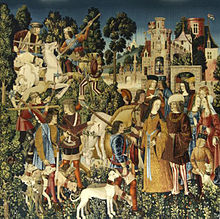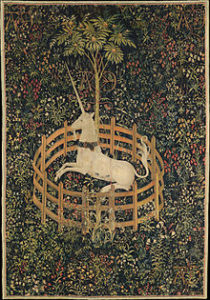The Hunt of the Unicorn
Cathy Koos
My sister, my niece and I often have meet-up holidays – we pick a spot, plan the itinerary, jump on a plane, and meet up for a fun adventure. We have met up in Las Vegas (once was enough); Colorado to ride old steam trains; Ireland for a castle patrol; and even Wyoming for a dude ranch week. So, a few years ago when we planned a trip to Scotland, I knew we had to see the Unicorn tapestries at Stirling Castle.

The_Unicorn_in_Captivity_-_Google_Art_Project.
The original “Hunt of the Unicorn” tapestries is a series of seven tapestries likely made in the Netherlands around 1500. Each piece depicts a scene during a hunt, with noblemen and hunters pursuing a unicorn. Interpretation is highly debated — likely a depiction of pagan or Christian symbols. Unicorns are a strong pagan symbol that can only be tamed by a virgin; other theories promote the unicorn as an allegory of Christ, the Virgin Mary and the Annunciation. Whatever the interpretation, the textiles are simply spectacular.
An obscure “AE” woven on each piece has sometimes been attributed to Anne of Brittany on celebration of her marriage to Louis XII, King of France, in 1499. However, the first recorded owner of the Unicorn tapestries was the Parisian Rochefoucauld family in 1680, nearly 200 years after the textiles were woven. But the original “for whom” and “where” questions remain murky.

The_Unicorn_in_Captivity_-_Google_Art_Project.
The original Unicorn tapestries now reside at The Cloisters in New York, so we would be seeing Stirling Castle’s recreation of the tapestries as part of their project to furnish the castle as it was in the 1540s when the palace was home to King James V’s wife Mary of Guise and her young daughter Mary Queen of Scots. West Dean College textile department collaborated with Historic Scotland to faithfully reproduce the hangings.
After a morning exploring the castle itself, we followed the tapestry signs to the Nether Bailey. Bright with natural light, this roomy purpose-built studio allows visitors to see both sides of the work in progress as the weavers sat in front of the looms.
While the original tapestries were woven with silk, these contemporary weavers substituted mercerized cotton to improve durability. Careful research was conducted to learn the native plants used as dyes, and sample weavings were displayed with the dye formula.

At the time we visited, some of the tapestries were completed and some were works-in-progress, so it was exciting to see both.
The weavers from West Dean College were diligent in their craft to faithfully reproduce these lovely tapestries, and it was a privilege to view these highly skilled weavers at work.
https://youtu.be/7pvlsggz35Y mesmerizing timelapse
https://youtu.be/7JV9c8L2HvY charming kids’ tour
https://youtu.be/bEpaO6HnswE national unicorn day
https://youtu.be/UkpN0S5D1q8 Unicorn Purifies Water, The Met
For next page click here